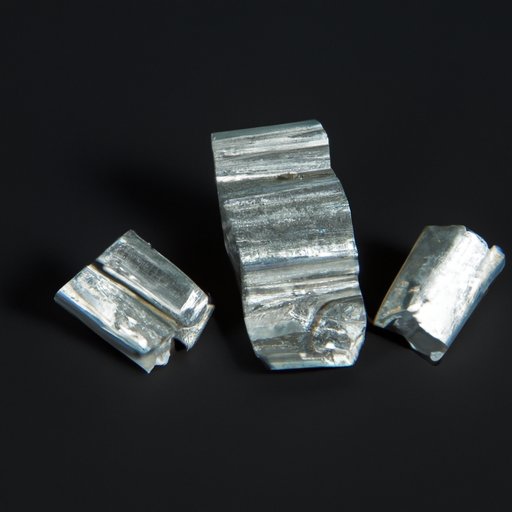Introduction
Aluminum is an abundant element that is widely used in a variety of industries, from commercial and residential applications to industrial production. In this article, we explore the aluminum element profile, including its history, physical and chemical properties, uses, extraction and refining process, environmental impact, recycling, and future trends.
History of Aluminum
Aluminum has been around since ancient times, but it was not until the 19th century that scientists were able to extract the element from its ore. The first successful extraction of aluminum was done by Hans Christian Oersted in 1825. Soon after, other scientists began experimenting with different methods for extracting aluminum from its ore. By the late 1800s, the Hall-Héroult process was developed, which allowed for large-scale production of aluminum.
In the early 1900s, demand for aluminum increased due to its use in transportation and construction. This led to further advances in aluminum production, such as the Bayer process, which enabled the economical production of alumina (the raw material for aluminum) from bauxite ore. By the 1950s, aluminum had become one of the most widely used metals in the world.
Properties of Aluminum
Aluminum is a silvery-white metal that is lightweight, malleable, and ductile. It has a low melting point and is a good conductor of heat and electricity. Aluminum is also corrosion-resistant, non-toxic, and non-magnetic.
Chemically, aluminum is an amphoteric element, meaning it can react with both acids and bases. It is also relatively unreactive, making it suitable for use in many industrial processes. Aluminum oxide (Al2O3) is the most common form of the element, and it is used in many products, from abrasives to ceramics.
Uses of Aluminum
Aluminum is widely used in a variety of industries, from industrial production to commercial and residential applications. In industry, aluminum is used to make aircraft, automobiles, appliances, and electronics. It is also used in the construction of buildings, bridges, and other structures. Aluminum is also commonly used in packaging, such as cans and foil.
Aluminum is also used in many consumer products, from cookware to furniture and sporting goods. Aluminum is also used in the production of coins and other currency, as well as in the manufacture of jewelry and decorative items.
Extraction and Refining Process of Aluminum
Aluminum is extracted from its ore, bauxite, through a series of steps. First, the ore is mined from the ground. Then, it is crushed and washed to remove impurities. Next, the ore is heated and treated with sodium hydroxide to produce alumina (Al2O3). Finally, the alumina is smelted with carbon to produce pure aluminum.
The smelting process requires high temperatures and large amounts of energy. After the aluminum is produced, it is then refined to remove any impurities. This is done using electrolysis, which involves passing an electric current through a solution containing dissolved aluminum ions. The resulting metal is then formed into ingots or cast into various shapes.

Environmental Impact of Aluminum Production
The production of aluminum has a significant environmental impact, particularly due to air and water pollution. The mining and smelting of bauxite ore releases dust and toxic chemicals into the air, while the refining process produces sulfur dioxide and fluoride emissions. Additionally, the production of aluminum requires large amounts of energy, which can contribute to global warming.
The mining of bauxite ore also has a negative impact on the environment, as it depletes natural resources and can cause soil erosion and degradation. Additionally, the waste generated during the refining process must be properly disposed of to avoid contamination of local ecosystems.
Recycling of Aluminum
Aluminum is 100% recyclable, making it one of the most recycled materials in the world. Recycling aluminum saves energy and reduces greenhouse gas emissions, as well as reducing the need for mining and smelting of new aluminum. Additionally, recycling aluminum helps conserve natural resources and reduce the amount of waste sent to landfills.
However, there are some challenges associated with recycling aluminum. For example, aluminum cans contain a variety of other materials, such as plastic lids and paper labels, which must be separated before they can be recycled. Additionally, aluminum is often contaminated with food and drink residue, which makes it difficult to recycle.
Future of Aluminum Industry
The demand for aluminum is expected to continue to grow in the coming years, driven by the increasing use of aluminum in the automotive and aerospace industries, as well as the growth of the construction industry. Additionally, aluminum is becoming increasingly popular in consumer products, such as furniture and electronics.
In order to meet the growing demand, aluminum producers are investing in new technologies and processes to improve efficiency and reduce costs. Additionally, more research is being conducted into ways to reduce the environmental impacts of aluminum production and make the process more sustainable.
Conclusion
Aluminum is a versatile and widely used element that has a long history and a wide range of applications. Its extraction and refining process has a significant environmental impact, but recycling aluminum can help reduce these impacts. As demand for aluminum continues to grow, producers are investing in new technologies to improve efficiency and sustainability.

